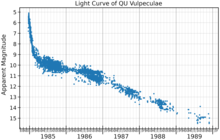QU Vulpeculae, also known as Nova Vulpeculae 1984 Number 2, was the second nova which occurred in 1984 in the constellation Vulpecula (PW Vulpeculae was the first). It was discovered by Peter Collins, an amateur astronomer from Cardiff, California at 22:08 UT on 22 December 1984. At the time of its discovery, the nova's apparent magnitude was 6.8. By the next night, Collins reported its brightness had increased to magnitude 5.6, making it visible to the naked eye.[4]
| Observation data Epoch J2000 Equinox J2000 | |
|---|---|
| Constellation | Vulpecula |
| Right ascension | 20h 26m 46.020s[1] |
| Declination | +27° 50′ 43.16″[1] |
| Apparent magnitude (V) | 5.3 Max. 17.9 Min.[2] |
| Astrometry | |
| Proper motion (μ) | RA: 1.325±0.509[1] mas/yr Dec.: −3.125±0.522[1] mas/yr |
| Parallax (π) | 0.7392 ± 0.3657 mas[1] |
| Distance | 1786+3495 −196[2] pc |
| Characteristics | |
| Variable type | Classical Nova, eclipsing binary |
| Other designations | |
| Database references | |
| SIMBAD | data |

QU Vulpeculae declined from peak brightness quite rapidly, and had faded by 3 magnitudes in just 40 days, so it is classified as a "fast" nova.[5]
All nova are binary stars, with a "donor" star orbiting a white dwarf. The two stars are so close to each other that material is transferred from the donor to the white dwarf. Since the two stars are separated by a distance comparable to the radius of the donor star, novae are often found to be eclipsing binaries, and QU Vulpeculae shows such eclipses. The eclipses produce a ~0.5 magnitude brightness drop, and they allow the orbital period, 2.68 hours, to be measured. This is an unusual orbital period for a cataclysmic variable star, falling within the "period gap" between 2 and 3 hours.[6]
A few months after the nova eruption, infrared spectroscopy revealed extremely strong emission in the 12.8 micron forbidden transition of singly ionized neon. It was the strongest emission in that spectral transition, relative to the source's continuum, that had ever been observed in an astronomical source.[7] QU Vulpeculae is an ONeMg neon nova, a nova with an oxygen-neon-magnesium white dwarf primary. A neon nova white dwarf is unusually massive, having a mass ≥ 1.2 M☉, approaching the Chandrasekhar limit.[8] However estimates of current mass of QU Vulpeculae's white dwarf are lower than this, which has led to suggestions that the white dwarf has lost some of its initial mass as a result of the nova outbursts.[9] It is believed that white dwarfs of this type are the remnants of main sequence stars with initial masses of 8 to 12 M☉.[10]
In the summer of 1985, QU Vulpeculae was detected in all four of the observing bands (1.49, 4.89, 14.94 and 22.46 GHz) available at that time at the Very Large Array. It was the first nova that was imaged shortly after its outburst in the radio regime, and multi-epoch observations showed that the ejecta was expanding.[11]
QU Vulpeculae is surrounded by a nova remnant, a planetary nebula-like shell of the material that was ejected during its outburst. Its remnant appears roughly spherical.[12] In 2020, its radius was measured to be about 2.1 arcseconds, meaning the shell has been expanding at a rate of about 0.058 arcseconds per year.[12]
References
edit- ^ a b c d e Brown, A. G. A.; et al. (Gaia collaboration) (August 2018). "Gaia Data Release 2: Summary of the contents and survey properties". Astronomy & Astrophysics. 616. A1. arXiv:1804.09365. Bibcode:2018A&A...616A...1G. doi:10.1051/0004-6361/201833051. Gaia DR2 record for this source at VizieR.
- ^ a b c Schaefer, Bradley E. (2018). "The distances to Novae as seen by Gaia". Monthly Notices of the Royal Astronomical Society. 481 (3): 3033–3051. arXiv:1809.00180. Bibcode:2018MNRAS.481.3033S. doi:10.1093/mnras/sty2388. S2CID 118925493.
- ^ "NOVA Vul 1984 b". SIMBAD. Centre de données astronomiques de Strasbourg. Retrieved 17 August 2019.
- ^ Green, Daniel W. E. (December 24, 1984). "N Vul 1984 No. 2; N Aql 1984; N Vul 1984 No. 1; 1984t". International Astronomical Union Circular (4023). Smithsonian Astrophysical Observatory, Cambridge, Massachusetts: Central Bureau for Astronomical Telegrams: 1. Bibcode:1984IAUC.4023....1C. Retrieved 18 August 2019.
- ^ Duerbeck, Hilmar W. (March 1987). "A Reference Catalogue and Atlas of Galactic Novae". Space Science Reviews. 45 (1–2): 1–14. Bibcode:1987SSRv...45....1D. doi:10.1007/BF00187826. S2CID 115854775.
- ^ Shafter, A.W.; Misselt, K.A.; Szkody, P.; Politano, M. (July 1995). "QU Vulpeculae: an Eclipsing Neon Nova in the Period Gap". Astrophysical Journal Letters. 448: L33. Bibcode:1995ApJ...448L..33S. doi:10.1086/309587.
- ^ Gehrz, R.D.; Grasdalen, G.L.; Hackwell, J.A. (November 1985). "A Neon Nova: Discovery of a Remarkable 12.8 Micron [Ne ii] Emission Line in Nova Vulpeculae 1984 Number 2". Astrophysical Journal Letters. 298: L47. Bibcode:1985ApJ...298L..47G. doi:10.1086/184564.
- ^ Gehrz, Robert D.; Truran, James W.; Williams, Robert E. (1993). Protostars and Planets III. Tucson, Arizona: University of Arizona Press. p. 75. Bibcode:1993prpl.conf...75G. ISBN 0-8165-1334-1.
- ^ Hachisu, Izumi; Kato, Mariko (January 2016). "Light-curve Analysis of Neon Novae". The Astrophysical Journal. 816 (1): 26. arXiv:1511.06819. Bibcode:2016ApJ...816...26H. doi:10.3847/0004-637X/816/1/26. S2CID 118690985.
- ^ Starrfield, S.; Sparks, W.M.; Truran, J.W. (April 1986). "Hydrodynamic Models for Novae with Ejecta Rich in Oxygen, Neon, and Magnesium". Astrophysical Journal Letters. 303: L5. Bibcode:1986ApJ...303L...5S. doi:10.1086/184642. hdl:2060/19860007770.
- ^ Taylor, A.R.; Seaquist, E.R.; Hollis, J.M.; Pottasch, S.R. (September 1987). "The unusual radio outburst of Nova Vulpeculae 1984 No 2". Astronomy and Astrophysics. 183: 38–46. Bibcode:1987A&A...183...38T.
- ^ a b Santamaría, E.; Guerrero, M. A.; Zavala, S.; Ramos-Larios, G.; Toalá, J. A.; Sabin, L. (2022). "Spatio-kinematic models of five nova remnants: Correlations between nova shell axial ratio, expansion velocity, and speed class". Monthly Notices of the Royal Astronomical Society. 512 (2): 2003–2013. arXiv:2202.13946. Bibcode:2022MNRAS.512.2003S. doi:10.1093/mnras/stac563.
